All Exams >
NEET >
Physical Chemistry for NEET >
All Questions
All questions of Equilibrium for NEET Exam
Ca(HCO3)2 is strongly heated and after equilibrium is attained, temperature changed to 25° C.

Kp = 36 (pressure taken in atm)
Thus, pressure set up due to CO2 is- a)36 atm
- b)18 atm
- c)12 atm
- d)6 atm
Correct answer is 'D'. Can you explain this answer?
Ca(HCO3)2 is strongly heated and after equilibrium is attained, temperature changed to 25° C.

Kp = 36 (pressure taken in atm)
Thus, pressure set up due to CO2 is
Kp = 36 (pressure taken in atm)
Thus, pressure set up due to CO2 is
a)
36 atm
b)
18 atm
c)
12 atm
d)
6 atm
|
|
Mira Joshi answered |
The reaction is as follow:-
Ca(HCO3)2(s)⇌CaO(s) + 2CO2 (g) + H2O(g)
At 25° C H2O goes in liquid state
Kp = (PCaO)1×(PCO2)2
(PCa(HCO3)2)
Since, Ca(HCO3)2, CaO and H2O are not in gaseous state, so their partial pressure is taken 1.
Putting all values, we have
36 = (PCO2)2
Or PCO2 = 6 atm
Ca(HCO3)2(s)⇌CaO(s) + 2CO2 (g) + H2O(g)
At 25° C H2O goes in liquid state
Kp = (PCaO)1×(PCO2)2
(PCa(HCO3)2)
Since, Ca(HCO3)2, CaO and H2O are not in gaseous state, so their partial pressure is taken 1.
Putting all values, we have
36 = (PCO2)2
Or PCO2 = 6 atm
Which of the following is more acidic? A solution with pH 5 or a solution with pH 3- a)solution with pH 5
- b)solution with pH 3
- c)both are equally acidic
- d)cannot be predicted from pH values
Correct answer is option 'B'. Can you explain this answer?
Which of the following is more acidic? A solution with pH 5 or a solution with pH 3
a)
solution with pH 5
b)
solution with pH 3
c)
both are equally acidic
d)
cannot be predicted from pH values
|
|
Dipika Singh answered |
**Solution:**
**pH Scale:**
The pH scale is used to measure the acidity or alkalinity of a solution. It ranges from 0 to 14, with 7 being considered neutral. Solutions with pH values below 7 are considered acidic, while solutions with pH values above 7 are considered alkaline or basic.
**Explanation:**
In this case, we are comparing a solution with pH 5 to a solution with pH 3 to determine which one is more acidic.
**pH 5 Solution:**
A solution with pH 5 is acidic because it is below the neutral pH of 7. However, it is less acidic compared to a solution with pH 3.
**pH 3 Solution:**
A solution with pH 3 is also acidic because it is below the neutral pH of 7. However, it is more acidic compared to a solution with pH 5.
**Comparing pH Values:**
The pH scale is logarithmic, which means that each whole number change in pH represents a tenfold change in acidity. In other words, a solution with pH 3 is ten times more acidic than a solution with pH 4, and a hundred times more acidic than a solution with pH 5.
Therefore, we can conclude that a solution with pH 3 is more acidic compared to a solution with pH 5.
**Conclusion:**
In summary, a solution with pH 3 is more acidic compared to a solution with pH 5. The pH scale is logarithmic, and each whole number change represents a tenfold change in acidity. Therefore, a solution with pH 3 is ten times more acidic than a solution with pH 4, and a hundred times more acidic than a solution with pH 5.
**pH Scale:**
The pH scale is used to measure the acidity or alkalinity of a solution. It ranges from 0 to 14, with 7 being considered neutral. Solutions with pH values below 7 are considered acidic, while solutions with pH values above 7 are considered alkaline or basic.
**Explanation:**
In this case, we are comparing a solution with pH 5 to a solution with pH 3 to determine which one is more acidic.
**pH 5 Solution:**
A solution with pH 5 is acidic because it is below the neutral pH of 7. However, it is less acidic compared to a solution with pH 3.
**pH 3 Solution:**
A solution with pH 3 is also acidic because it is below the neutral pH of 7. However, it is more acidic compared to a solution with pH 5.
**Comparing pH Values:**
The pH scale is logarithmic, which means that each whole number change in pH represents a tenfold change in acidity. In other words, a solution with pH 3 is ten times more acidic than a solution with pH 4, and a hundred times more acidic than a solution with pH 5.
Therefore, we can conclude that a solution with pH 3 is more acidic compared to a solution with pH 5.
**Conclusion:**
In summary, a solution with pH 3 is more acidic compared to a solution with pH 5. The pH scale is logarithmic, and each whole number change represents a tenfold change in acidity. Therefore, a solution with pH 3 is ten times more acidic than a solution with pH 4, and a hundred times more acidic than a solution with pH 5.
Rate of reaction is proportional to product of molar concentration of reactants with each concentration term raised to power its stoichiometric coefficient. This is the law of- a)Equilibrium
- b)Mass action
- c)Constant proportion
- d)Reciprocal proportions
Correct answer is option 'B'. Can you explain this answer?
Rate of reaction is proportional to product of molar concentration of reactants with each concentration term raised to power its stoichiometric coefficient. This is the law of
a)
Equilibrium
b)
Mass action
c)
Constant proportion
d)
Reciprocal proportions

|
Cutie Pie answered |
Mass action
Which one of the following molecular hydrides acts as a Lewis acid? [2010]- a)NH3
- b)H2O
- c)B2H6
- d)CH4
Correct answer is option 'C'. Can you explain this answer?
Which one of the following molecular hydrides acts as a Lewis acid? [2010]
a)
NH3
b)
H2O
c)
B2H6
d)
CH4

|
Jatin Chakraborty answered |
Boron in B2H6 is electron deficient
The solubility products of CuS, Ag2S and HgS are 10–31, 10–44, 10–54 respectively. The solubilities of these sulphides are in the ordera)Ag2S > HgS > CuS [1997]b)Ag2S > CuS > HgSc)HgS > Ag2S > CuSd)CuS > Ag2S > HgSCorrect answer is option 'D'. Can you explain this answer.
|
|
Ananya Das answered |

For Binary salts like CuS & HgS, solubilty,




∴ The order is CuS > Ag2S > HgS
Consider the following equilibrium in a closed container
 At a fixed temperature, the volume of a reaction container is halved. For this change, which of the following statements holds true regarding the equilibrium constant (Kp) and degree of dissociation (α) ?
At a fixed temperature, the volume of a reaction container is halved. For this change, which of the following statements holds true regarding the equilibrium constant (Kp) and degree of dissociation (α) ?- a)Neither Kp nor α change
- b)Both Kp and α change
- c)Kp changes but α does not change
- d)Kp does not change but α changes
Correct answer is option 'D'. Can you explain this answer?
Consider the following equilibrium in a closed container

At a fixed temperature, the volume of a reaction container is halved. For this change, which of the following statements holds true regarding the equilibrium constant (Kp) and degree of dissociation (α) ?
a)
Neither Kp nor α change
b)
Both Kp and α change
c)
Kp changes but α does not change
d)
Kp does not change but α changes
|
|
Geetika Shah answered |
We know that Kp depends only on Temperature. As the temp. remains constant , Kp also remains constant.
α depends on the concentration of the reactant
So as the volume of the reaction container is halved, α also changes
So option d is correct.
α depends on the concentration of the reactant
So as the volume of the reaction container is halved, α also changes
So option d is correct.
Following equilibrium is set up at 298 K in a 1 L flask.

If one starts with 2 moles of A and 1 mole of B, it is found that moles of B and D are equal.Thus Kc is - a)9.0
- b)15.0
- c)3.0
- d)0.0667
Correct answer is option 'B'. Can you explain this answer?
Following equilibrium is set up at 298 K in a 1 L flask.

If one starts with 2 moles of A and 1 mole of B, it is found that moles of B and D are equal.Thus Kc is
If one starts with 2 moles of A and 1 mole of B, it is found that moles of B and D are equal.Thus Kc is
a)
9.0
b)
15.0
c)
3.0
d)
0.0667

|
Sushil Kumar answered |
For the equilibrium reaction:
A+2B ⇌ 2C+D
volume of flask = 1L
Initial moles of A = 2 mol
initial concentration of A=[A]i = 2 M
initial mole of B = 1 mol
[B]i = 1 M
[A]eq = 2-x, [B]eq = 1-2x, [C]eq = x, [D]eq = 3x
Given [D]eq = 1 * 1L
= 1 M
Thus x = 1M
[A]eq = 1, [B]eq = -1, [C]eq = 1, [D] = 3
Kc = {([D]eq)3 * ([C]eq)}/{[A]eq * ([B]eq)2}
= Kc = {(3)3*1}/{1*(-1)2}
= 27/1
= 27
A+2B ⇌ 2C+D
volume of flask = 1L
Initial moles of A = 2 mol
initial concentration of A=[A]i = 2 M
initial mole of B = 1 mol
[B]i = 1 M
[A]eq = 2-x, [B]eq = 1-2x, [C]eq = x, [D]eq = 3x
Given [D]eq = 1 * 1L
= 1 M
Thus x = 1M
[A]eq = 1, [B]eq = -1, [C]eq = 1, [D] = 3
Kc = {([D]eq)3 * ([C]eq)}/{[A]eq * ([B]eq)2}
= Kc = {(3)3*1}/{1*(-1)2}
= 27/1
= 27
Which of the following is not a general characteristic of equilibria involving physical processes?- a)Equilibrium is possible only in a closed system at a given temperature.
- b)All measurable properties of the system remain constant.
- c)All the physical processes stop at equilibrium.
- d)The opposing processes occur at the same rate and there is dynamic but stable condition.
Correct answer is option 'C'. Can you explain this answer?
Which of the following is not a general characteristic of equilibria involving physical processes?
a)
Equilibrium is possible only in a closed system at a given temperature.
b)
All measurable properties of the system remain constant.
c)
All the physical processes stop at equilibrium.
d)
The opposing processes occur at the same rate and there is dynamic but stable condition.
|
|
Mira Sharma answered |
All the physical processes like melting of ice and freezing of water, etc., do not stop at equilibrium.
The exothermic formaton of ClF3 is represented by the equation -Cl2(g)+3F2(g) 2ClF3(g) ; ΔrH = -329 kJWhich of the following will increase the quantity of ClF3 in an equilibrium mixture of Cl2, F2 and ClF3 ?
2ClF3(g) ; ΔrH = -329 kJWhich of the following will increase the quantity of ClF3 in an equilibrium mixture of Cl2, F2 and ClF3 ?- a)Removing Cl2
- b)Increasing the temperature
- c)Adding F2
- d)Increasing the volume of the container
Correct answer is option 'C'. Can you explain this answer?
The exothermic formaton of ClF3 is represented by the equation -
Cl2(g)+3F2(g) 2ClF3(g) ; ΔrH = -329 kJ
2ClF3(g) ; ΔrH = -329 kJ
Which of the following will increase the quantity of ClF3 in an equilibrium mixture of Cl2, F2 and ClF3 ?
a)
Removing Cl2
b)
Increasing the temperature
c)
Adding F2
d)
Increasing the volume of the container
|
|
Hansa Sharma answered |
The correct answer is option C
According to Le-Chatelier's Principle, if a system at equilibrium is subjected to a change of concentration pressure or temperature then the equilibrium is shifted in such a way as to nullify the effect of change.
In the given reaction, if the concentration of F2 is increased then the reaction will shift in the forward direction in order to increase the concentration of ClF3.
Hence,
Adding F2 .
According to Le-Chatelier's Principle, if a system at equilibrium is subjected to a change of concentration pressure or temperature then the equilibrium is shifted in such a way as to nullify the effect of change.
In the given reaction, if the concentration of F2 is increased then the reaction will shift in the forward direction in order to increase the concentration of ClF3.
Hence,
Adding F2 .
0.023 g of sodium metal is reacted with 100 cm3 of water. The pH of the resulting solution is ______.- a)10
- b)8
- c)9
- d)12
Correct answer is option 'D'. Can you explain this answer?
0.023 g of sodium metal is reacted with 100 cm3 of water. The pH of the resulting solution is ______.
a)
10
b)
8
c)
9
d)
12
|
|
Naina Bansal answered |
Na + H2O –> NaOH
[NaOH] = (0.023/23)0.1 = 0.01
so pH is 12
Ag+(aq)+NH3(aq)  [Ag(NH3)(aq)]+ ; K, = 3.5x 10-3
[Ag(NH3)(aq)]+ ; K, = 3.5x 10-3
[Ag(NH3)]+ (aq)+NH3(aq)  [Ag(NH3)2]2+(aq); K2 = 1.7x 10-3
[Ag(NH3)2]2+(aq); K2 = 1.7x 10-3
Formation constant of [Ag(NH3)2]+(aq) is- a)2.06
- b)5.2 x 10-3
- c)5.95 x 10-6
- d)None of these
Correct answer is option 'C'. Can you explain this answer?
Ag+(aq)+NH3(aq)  [Ag(NH3)(aq)]+ ; K, = 3.5x 10-3
[Ag(NH3)(aq)]+ ; K, = 3.5x 10-3
[Ag(NH3)]+ (aq)+NH3(aq) [Ag(NH3)2]2+(aq); K2 = 1.7x 10-3
[Ag(NH3)2]2+(aq); K2 = 1.7x 10-3
Formation constant of [Ag(NH3)2]+(aq) is
[Ag(NH3)]+ (aq)+NH3(aq)
Formation constant of [Ag(NH3)2]+(aq) is
a)
2.06
b)
5.2 x 10-3
c)
5.95 x 10-6
d)
None of these
|
|
Krishna Iyer answered |
The correct answer is Option C.
To get the formation constant add both reactions-
So the resultant K = K1 × K2
= 3.5×1.7×10−3
= 5.95×10−6
To get the formation constant add both reactions-
So the resultant K = K1 × K2
= 3.5×1.7×10−3
= 5.95×10−6
Graphite is added to a vessel that contains CO2(g) at a pressure of 0.830 atm at a certain high temperature. The pressure rises due to a reaction that produces CO (g). The total pressure reaches an equilibrium value of 1.366 atm. Calculate the equilibrium constant of the following reaction.

- a)2.909 atm
- b)6.909 atm
- c)4.909 atm
- d)3.909 atm
Correct answer is option 'D'. Can you explain this answer?
Graphite is added to a vessel that contains CO2(g) at a pressure of 0.830 atm at a certain high temperature. The pressure rises due to a reaction that produces CO (g). The total pressure reaches an equilibrium value of 1.366 atm. Calculate the equilibrium constant of the following reaction.

a)
2.909 atm
b)
6.909 atm
c)
4.909 atm
d)
3.909 atm
|
|
Hansa Sharma answered |
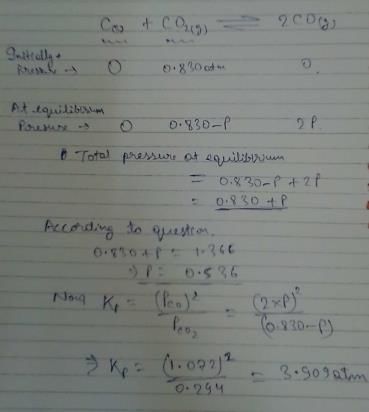
How many of the following are Lewis bases?
Correct answer is '6'. Can you explain this answer?
How many of the following are Lewis bases?
|
|
Pooja Shah answered |
Total number of compounds acting as Lewis base in the given example is 6. H+ and BF3 are electron deficient so they can't act as Lewis base while FeCl3 acts as Lewis acid so all the other compounds except these three are Lewis base.
The pH of a 0.1 molar solution of the acid HQ is 3. The value of the ionization constant, Ka of this acid is - [AIEEE-2012] - a)1 × 10-3
- b)1 × 10-5
- c)1 × 10-7
- d)3 × 10-1
Correct answer is option 'B'. Can you explain this answer?
The pH of a 0.1 molar solution of the acid HQ is 3. The value of the ionization constant, Ka of this acid is - [AIEEE-2012]
a)
1 × 10-3
b)
1 × 10-5
c)
1 × 10-7
d)
3 × 10-1
|
|
Naina Bansal answered |
HQ will dissociate as
H2O + HQ ↔ H3O^+ + Q-
Ka = [H3O^+] [Q-] / [HQ]
-log [H3O^+] = pH
- log [H3O^+] = 3
[H3O^+] = 10^-3
[H3O+] = [Q-] = 10-3
Ka = ( 10^-3)^2 / (0.1 - 10^-3) = ( 10^-3)^2 / (0.1) = 1 x 10^-5
In which of the following reaction can equilibrium be attained- a)Reversible reaction
- b)Cyclic reaction
- c)Decomposition reaction
- d)Irreversible reaction
Correct answer is option 'A'. Can you explain this answer?
In which of the following reaction can equilibrium be attained
a)
Reversible reaction
b)
Cyclic reaction
c)
Decomposition reaction
d)
Irreversible reaction
|
|
Rajat Kapoor answered |
Reversible Reaction
The common observation for any reactions when they are reacted in closed containers would not go to completion, for some given conditions like temperature and pressure.
For all those cases, only the reactants are found to be present in the intial stages, but with the progress of reaction, the reactants concentration decreases and to that of the products increases. A stage is finally reached where there is no more change of reactants and products concentration is observed. The state where the reactants and products concentrations do not show any visible change within a given period of time is better known as the state of chemical equilibrium.
The reactant amount that remains unused depends upon the experimental conditions like concentration of components, temperature of the system, pressure of the system and the reaction nature.
Direction (Q. Nos. 1-10) This section contains 10 multiple choice questions. Each question has four
choices (a), (b), (c) and (d), out of which ONLY ONE option is correct.Q. Vapour pressure of NH4HS (s)is 20 mm at 25°C, for

Total pressure when NH4HS (s) dissociates at 25°Cin a vessel which already contains H2S (g)at a pressure of 15 mm, is- a)25 mm
- b)50 mm
- c)5 mm
- d)10 mm
Correct answer is option 'A'. Can you explain this answer?
Direction (Q. Nos. 1-10) This section contains 10 multiple choice questions. Each question has four
choices (a), (b), (c) and (d), out of which ONLY ONE option is correct.
choices (a), (b), (c) and (d), out of which ONLY ONE option is correct.
Q. Vapour pressure of NH4HS (s)is 20 mm at 25°C, for

Total pressure when NH4HS (s) dissociates at 25°Cin a vessel which already contains H2S (g)at a pressure of 15 mm, is
Total pressure when NH4HS (s) dissociates at 25°Cin a vessel which already contains H2S (g)at a pressure of 15 mm, is
a)
25 mm
b)
50 mm
c)
5 mm
d)
10 mm
|
|
Hansa Sharma answered |
The correct answer is Option A.
NH4HS -------> NH3 + H2S
Let P be the pressure at eq. of NH3 and H2S.
Therefore, Kp = P2
= (20 / 2)2
= 100 mm
= 100
Also, Kp = (15 + P) (P)
100 = 15 P + P2
P2 + 15 P – 100 = 0
P = 5
Total pressure = 15 + 2(P)
= 15 + 2(5)
= 25 mm
NH4HS -------> NH3 + H2S
Let P be the pressure at eq. of NH3 and H2S.
Therefore, Kp = P2
= (20 / 2)2
= 100 mm
= 100
Also, Kp = (15 + P) (P)
100 = 15 P + P2
P2 + 15 P – 100 = 0
P = 5
Total pressure = 15 + 2(P)
= 15 + 2(5)
= 25 mm
For the reaction  [AIEEE-2002]
[AIEEE-2002]- a)

- b)

- c)

- d)RT
Correct answer is option 'C'. Can you explain this answer?
For the reaction 
[AIEEE-2002]
a)
b)
c)
d)
RT
|
|
Raghav Bansal answered |
The correct answer is option C
Kp = Kc (RT)Δn;

Kp = Kc (RT)Δn;

Following equilibrium is set up at 1000 K and 1 bar in a 5 L flask,

At equilibrium, NO2 is 50% o f the total volume. Thus, equilibrium constant Kc is - a)0.133
- b)0.266
- c)0.200
- d)0.400
Correct answer is option 'A'. Can you explain this answer?
Following equilibrium is set up at 1000 K and 1 bar in a 5 L flask,

At equilibrium, NO2 is 50% o f the total volume. Thus, equilibrium constant Kc is
At equilibrium, NO2 is 50% o f the total volume. Thus, equilibrium constant Kc is
a)
0.133
b)
0.266
c)
0.200
d)
0.400

|
Manish Aggarwal answered |
The correct answer is Option A.
N2O4 ⇌ 2NO2
Initial 1 0
Equilibrium 1−x 2x
N2O4 ⇌ 2NO2
Initial 1 0
Equilibrium 1−x 2x
Total moles = 1 - x + 2x
NO2 is 50% of the total volume when equilibrium is set up.
Thus, the volume fraction (at equilibrium) of NO2 = 50/100 = 0.5 = ½
So, 2x / (1+x) = ½
=> x = ⅓
Thus, the volume fraction (at equilibrium) of NO2 = 50/100 = 0.5 = ½
So, 2x / (1+x) = ½
=> x = ⅓
For 1 litre;
Kc = [NO2] / [N2O4]
= [4*(1/9)] / [⅔]
= 0.66;
Kc = [NO2] / [N2O4]
= [4*(1/9)] / [⅔]
= 0.66;
For 5 litres;
Kc = 0.66 / 5
= 0.133
Thus, option A is correct.
Kc = 0.66 / 5
= 0.133
Thus, option A is correct.
 Q. What is [PCI5] eq?
Q. What is [PCI5] eq?- a)4.09 x 10-4 mol L-1
- b)2.444 x 103 mol L-1
- c)4.09 x 10-6 mol L-1
- d)2.444 x 105 mol L-1
Correct answer is option 'A'. Can you explain this answer?
Q. What is [PCI5] eq?
a)
4.09 x 10-4 mol L-1
b)
2.444 x 103 mol L-1
c)
4.09 x 10-6 mol L-1
d)
2.444 x 105 mol L-1
|
|
Riya Banerjee answered |
The correct answer is Option A.
PPCl3 = [PCl3]RT
PCl2 = [Cl2]RT
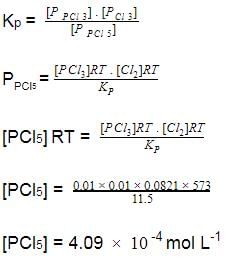
PPCl3 = [PCl3]RT
PCl2 = [Cl2]RT

Passage IIThe complex ion of Fe2+ with the chelating agent dipyridyl (abbreviated dipy) has been studied kinetically in both the forward and backward directions. For the complexion reaction,
the rate of the formation of the complex at 298 K is given by rate = (1. 45 x 1013 L3mol -3s-1) [Fe 2+] [dipy]3 and for the reverse reaction , the rate of disapperance of the complex is
 Q. What is equilibrium constant for the equilibrium ?
Q. What is equilibrium constant for the equilibrium ? 
- a)8.4138x 10-18
- b)2.3770x 1017
- c)1.1885x 1017
- d)5.9426x 106
Correct answer is option 'C'. Can you explain this answer?
Passage II
The complex ion of Fe2+ with the chelating agent dipyridyl (abbreviated dipy) has been studied kinetically in both the forward and backward directions. For the complexion reaction,
the rate of the formation of the complex at 298 K is given by rate = (1. 45 x 1013 L3mol -3s-1) [Fe 2+] [dipy]3 and for the reverse reaction , the rate of disapperance of the complex is
Q. What is equilibrium constant for the equilibrium ?
a)
8.4138x 10-18
b)
2.3770x 1017
c)
1.1885x 1017
d)
5.9426x 106
|
|
Suresh Iyer answered |
The correct answer is Option C.
Fe2+ + 3 dipy -----> Fe(dipy)32+
Rf = Kf [Fe2+] [dipy]3
Rb = Kb [Fe(dipy)32+]
Keq = Kb [Fe(dipy)32+] / Kf [Fe2+] [dipy]3
Rf = Rb
Keq = Kf / Kb
= 1. 45 x 1013 / 1.24 x 10-4
= 1.885 x 1017
Fe2+ + 3 dipy -----> Fe(dipy)32+
Rf = Kf [Fe2+] [dipy]3
Rb = Kb [Fe(dipy)32+]
Keq = Kb [Fe(dipy)32+] / Kf [Fe2+] [dipy]3
Rf = Rb
Keq = Kf / Kb
= 1. 45 x 1013 / 1.24 x 10-4
= 1.885 x 1017
Assume following equilibria when total pressure set up in each are equal to 1 atm, and equilibrium constant (Kp) as K1; K2 and K3


Thus,- a) K1 = K2 = K3
- b)K1 < K2 < K3
- c)K3 < K2 < K1
- d)None of these
Correct answer is option 'C'. Can you explain this answer?
Assume following equilibria when total pressure set up in each are equal to 1 atm, and equilibrium constant (Kp) as K1; K2 and K3


Thus,
Thus,
a)
K1 = K2 = K3
b)
K1 < K2 < K3
c)
K3 < K2 < K1
d)
None of these

|
Pioneer Academy answered |
The correct answer is option C
CaCO3 → CaO + CO2
Kp = k1 = Pco2
total pressure of container P
k1 = p
NH4HS → NH3 + H2S
PNH3 = PH2S = P0
P0 + P0 = p (total pressure)
P0 = p/2
k2 = kp = [PNH3][PH2s] p24
NH2CoNH2 → 2NH3 + CO2
PNH3 = 2P0 PCO2 = P0
2P0 + P0 = P
CaCO3 → CaO + CO2
Kp = k1 = Pco2
total pressure of container P
k1 = p
NH4HS → NH3 + H2S
PNH3 = PH2S = P0
P0 + P0 = p (total pressure)
P0 = p/2
k2 = kp = [PNH3][PH2s] p24
NH2CoNH2 → 2NH3 + CO2
PNH3 = 2P0 PCO2 = P0
2P0 + P0 = P
At 1000 K, pressure of CO2 in equilibrium with CaCO3 and CaO is equal to 2.105 atm. The equilibrium constant for the reaction,

is 1.9 at the same temperature when pressure are in atm. Solid C, CaO, and CaCO3 are mixed and allowed to come to equilibrium at 1000 K in a closed vessel.Q. What is the pressure of CO (g)at equilibrium (in atm)?
Correct answer is '2'. Can you explain this answer?
At 1000 K, pressure of CO2 in equilibrium with CaCO3 and CaO is equal to 2.105 atm. The equilibrium constant for the reaction,

is 1.9 at the same temperature when pressure are in atm. Solid C, CaO, and CaCO3 are mixed and allowed to come to equilibrium at 1000 K in a closed vessel.
is 1.9 at the same temperature when pressure are in atm. Solid C, CaO, and CaCO3 are mixed and allowed to come to equilibrium at 1000 K in a closed vessel.
Q. What is the pressure of CO (g)at equilibrium (in atm)?

|
Learners Habitat answered |
K= (partial pressure of co2/(partial pressure of co2)
since k =1.9
So 1.9 = (partial pressure of co)2/2.105
(partial pressure of co)2 =2.105×1.9
= 3.99 = 4
(partial pressure of co) =2
since k =1.9
So 1.9 = (partial pressure of co)2/2.105
(partial pressure of co)2 =2.105×1.9
= 3.99 = 4
(partial pressure of co) =2
Ca(HCO3)2 decomposes as,
Ca (HCO3)2(s) ⇌ CaCO3(s) + H2O(g) + CO2(g)
Equilibrium pressure is found to be 0.12 bar. What is pco2 if the reaction mixture also contains H2O(g)at 0.20 bar?
- a) 0.20 bar
- b) 0.017 ba
- c)0.040 bar
- d)0.10 bar
Correct answer is option 'B'. Can you explain this answer?
Ca(HCO3)2 decomposes as,
Ca (HCO3)2(s) ⇌ CaCO3(s) + H2O(g) + CO2(g)
Equilibrium pressure is found to be 0.12 bar. What is pco2 if the reaction mixture also contains H2O(g)at 0.20 bar?
Equilibrium pressure is found to be 0.12 bar. What is pco2 if the reaction mixture also contains H2O(g)at 0.20 bar?
a)
0.20 bar
b)
0.017 ba
c)
0.040 bar
d)
0.10 bar

|
Top Rankers answered |
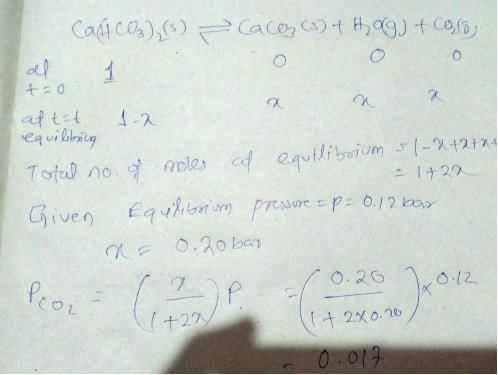
For HF, pKa = 3.45. What is the pH of an aqueous buffer solution that is 0.1M HF (aq) and 0.300 M KF (aq)?
a)11.03b)2.97c)10.07d)3.93 Correct answer is option 'D'. Can you explain this answer?
|
|
Suresh Iyer answered |
Given, pKa = 3.45
Concentration of HF = 0.1 M, concentration of KF = 0.300 M
For acidic buffer;
pH = pKa + log [salt of weak acid]/[weak acid]
= 3.45 + log0.3/0.1
= 3.45 + 0.48
= 3.93
Concentration of HF = 0.1 M, concentration of KF = 0.300 M
For acidic buffer;
pH = pKa + log [salt of weak acid]/[weak acid]
= 3.45 + log0.3/0.1
= 3.45 + 0.48
= 3.93
How many gm of solid NaOH must be added to 100 ml of a buffer solution which is 0.1 M each w.r.t. Acid HA and salt Na+ A- to make the pH of solution 5.5. Given pKa(HA) = 5 (Use antilog (0.5)= 3.16)- a)2.08 × 10-1
- b)3.05 × 10-3
- c)2.01 × 10-2
- d)None of these
Correct answer is option 'A'. Can you explain this answer?
How many gm of solid NaOH must be added to 100 ml of a buffer solution which is 0.1 M each w.r.t. Acid HA and salt Na+ A- to make the pH of solution 5.5. Given pKa(HA) = 5 (Use antilog (0.5)= 3.16)
a)
2.08 × 10-1
b)
3.05 × 10-3
c)
2.01 × 10-2
d)
None of these

|
Knowledge Hub answered |
Suppose x m. mole NaOH was added
H2O (l)  H2O(s) ; ΔH = -qApplication of pressure on this equilibrium
H2O(s) ; ΔH = -qApplication of pressure on this equilibrium- a)cause formation of more ice
- b)cause fusion of ice
- c)has no effect
- d)lower the melting point
Correct answer is option 'B,D'. Can you explain this answer?
H2O (l)  H2O(s) ; ΔH = -q
H2O(s) ; ΔH = -q
 H2O(s) ; ΔH = -q
H2O(s) ; ΔH = -qApplication of pressure on this equilibrium
a)
cause formation of more ice
b)
cause fusion of ice
c)
has no effect
d)
lower the melting point
|
|
Krishna Iyer answered |
The correct answers are Options B and D.
As we know that reaction is exothermic it means heat is released in the reaction so, if we apply pressure then reaction will proceed in backward direction but if there is gas phase equilibrium the reaction will shift in that direction in which less number of moles are present. If pressure increases then the ice will melt and ice gets more energy at low temp. To melt ,so it’s melting point decreases.
As we know that reaction is exothermic it means heat is released in the reaction so, if we apply pressure then reaction will proceed in backward direction but if there is gas phase equilibrium the reaction will shift in that direction in which less number of moles are present. If pressure increases then the ice will melt and ice gets more energy at low temp. To melt ,so it’s melting point decreases.
The equilibrium constant for the following reaction, is 1.6 x 105 at 1024 K.
HBr (g)at 10.0 bar is introduced into a sealed container at 1024 K. Thus, partial pressure of H2(g)and Br2(g), together is- a)10 bar
- b)0.05 bar
- c)0.025 bar
- d)0.10 bar
Correct answer is option 'A'. Can you explain this answer?
The equilibrium constant for the following reaction, is 1.6 x 105 at 1024 K.
HBr (g)at 10.0 bar is introduced into a sealed container at 1024 K. Thus, partial pressure of H2(g)and Br2(g), together is
a)
10 bar
b)
0.05 bar
c)
0.025 bar
d)
0.10 bar
|
|
Rahul Bansal answered |
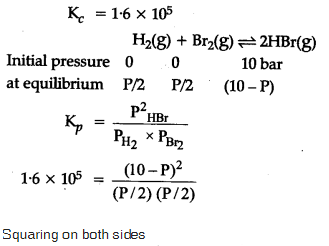
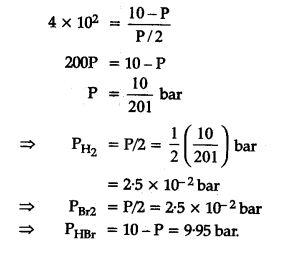
=> 10 bar approximately
. What is the molar solubility (s) of Ba3(PO4)2 in terms of Ksp?- a)s = [Ksp/27]1/5
- b)s = Ksp1/5
- c)s = Ksp1/2
- d)s = [Ksp/108]1/5
Correct answer is option 'D'. Can you explain this answer?
. What is the molar solubility (s) of Ba3(PO4)2 in terms of Ksp?
a)
s = [Ksp/27]1/5
b)
s = Ksp1/5
c)
s = Ksp1/2
d)
s = [Ksp/108]1/5

|
Mohit Rajpoot answered |
Ba3(PO4)2 ⇌ 3Ba+2 (2PO4)-3

Ksp = [Ba+2>]3 [(PO4)-3]2
[3s]3[2s]2
Ksp = 108s5
Or s = (Ksp/108)⅕

Ksp = [Ba+2>]3 [(PO4)-3]2
[3s]3[2s]2
Ksp = 108s5
Or s = (Ksp/108)⅕
Equal volume of two solution having pH = 2 and pH = 10 are mixed together at 90°C. Then pH of resulting solution is : (Take Kw at 90°C = 10-12) - a)2 + log 2
- b)10 - log 2
- c)7
- d)6
Correct answer is option 'D'. Can you explain this answer?
Equal volume of two solution having pH = 2 and pH = 10 are mixed together at 90°C. Then pH of resulting solution is : (Take Kw at 90°C = 10-12)
a)
2 + log 2
b)
10 - log 2
c)
7
d)
6
|
|
Geetika Shah answered |
kW = 10-12
Therefore range of pH scale. 0 to -log10-12
= 0 to 12
Since we have a strong acid and strong base mixture, the resultant solution will be neutral. So, the solution will have pH = 6
Therefore range of pH scale. 0 to -log10-12
= 0 to 12
Since we have a strong acid and strong base mixture, the resultant solution will be neutral. So, the solution will have pH = 6
The [Ag+(aq)] = 10-5 in a solution .The [Cl–(aq)] to precipitate AgCl having Ksp of 1.8×10-10 M2 is — M
- a)10-7
- b)10-8
- c)10-9
- d)10-5
Correct answer is option 'D'. Can you explain this answer?
The [Ag+(aq)] = 10-5 in a solution .The [Cl–(aq)] to precipitate AgCl having Ksp of 1.8×10-10 M2 is — M
a)
10-7
b)
10-8
c)
10-9
d)
10-5
|
|
Hansa Sharma answered |
For precipitation, Qrkn > Ksp, then tto establish equilibrium, ions will combine to give molecule as ppt.
So applying the above concept,
1.8×10-10 < [Ag+][Cl-]
1.8×10-10 < 10-5 × [Cl-]
Or [Cl-] > 1.8×10-5
By seeing the option, only option d satisfies this condtion.
So applying the above concept,
1.8×10-10 < [Ag+][Cl-]
1.8×10-10 < 10-5 × [Cl-]
Or [Cl-] > 1.8×10-5
By seeing the option, only option d satisfies this condtion.
For the following electrochemical cell reaction at 298 K,

E°cell = 1.10 V

- a)0.027
- b)37.22
- c)0.012
- d)85.73
Correct answer is option 'B'. Can you explain this answer?
For the following electrochemical cell reaction at 298 K,

E°cell = 1.10 V

E°cell = 1.10 V
a)
0.027
b)
37.22
c)
0.012
d)
85.73

|
Manish Aggarwal answered |
Zn(s) + Cu2+(aq) ⇌ Cu(s) + Zn2+(aq),
Eo = +1.10V
∴ Eo = 0.0591/n log10Keq
Eo = +1.10V
∴ Eo = 0.0591/n log10Keq
because at equilibrium,
Ecell = 0
(n = number of electrons exchanged = 2)
1.10 = 0.0591/2 log10Keq
2.20/0.0591 = log10Keq
(n = number of electrons exchanged = 2)
1.10 = 0.0591/2 log10Keq
2.20/0.0591 = log10Keq
Keq = antilog37.225
Solubility of BaCl2 if Ksp is 10-6 at 25°C is- a)Cannot be predicted
- b)6.3 10-3 M
- c)10-6 M
- d)10-3 M
Correct answer is option 'B'. Can you explain this answer?
Solubility of BaCl2 if Ksp is 10-6 at 25°C is
a)
Cannot be predicted
b)
6.3 10-3 M
c)
10-6 M
d)
10-3 M
|
|
Ram Mohith answered |
BaCl₂ ⇔ Ba²⁺ + 2Cl⁻
Ksp = (s)(2s)² = 4s³
Given, 4s³ = 10⁻⁶
⇒s³ = 0.25 ⨯ 10⁻⁶
⇒s = (0.25)³ ⨯ 10⁻²
⇒s = 0.629 ⨯ 10⁻²
⇒s = 6.3 ⨯ 10⁻³
For the reversible reaction, 

In a reaction vessel, [NO]= [O2]= 0.01 mol L-1 and [NO2]= 0.1 mol L-1 then above reaction is - a)shifted in forward direction
- b)shifted in backward direction
- c)in equilibrium
- d)not predictable in the absence of required data
Correct answer is option 'A'. Can you explain this answer?
For the reversible reaction, 

In a reaction vessel, [NO]= [O2]= 0.01 mol L-1 and [NO2]= 0.1 mol L-1 then above reaction is
In a reaction vessel, [NO]= [O2]= 0.01 mol L-1 and [NO2]= 0.1 mol L-1 then above reaction is
a)
shifted in forward direction
b)
shifted in backward direction
c)
in equilibrium
d)
not predictable in the absence of required data
|
|
Lavanya Menon answered |
On substituting the values of conc. of NO, O2 and NO2 in given rate equation, we get a +ve (positive) value indicating that the reaction takes place in forward direction.
A sample of N2O4(g)with a pressure of 1.00 atm is placed in a flask. When equilibrium is reached, 20% of N2O4(g)has been converted to NO2(g) If the original pressure is made 10% of the earlier pressure, then per cent dissociation will be
If the original pressure is made 10% of the earlier pressure, then per cent dissociation will be- a)20%
- b)42%
- c)54%
- d)62%
Correct answer is option 'C'. Can you explain this answer?
A sample of N2O4(g)with a pressure of 1.00 atm is placed in a flask. When equilibrium is reached, 20% of N2O4(g)has been converted to NO2(g)
If the original pressure is made 10% of the earlier pressure, then per cent dissociation will be
a)
20%
b)
42%
c)
54%
d)
62%

|
Lohit Matani answered |
Correct answer is A.
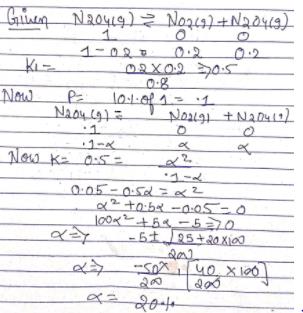
We know that the relationship between Kc and Kp is Kp = Kc (RT)Δn
What would be the value of Δn for the reaction NH4Cl (s) ⇔ NH3 (g) + HCl (g)
a)1b)0.5c)1.5d)2Correct answer is option 'D'. Can you explain this answer?
|
|
Nandini Patel answered |
The answer is d.
The relationship between Kp and Kc is
The relationship between Kp and Kc is
Kp = Kc (RT) ∆n
Where ∆n = (number of moles of gaseous products) – (number of moles of gaseous reactants)
For the reaction,
NH4C1(s) ⇆ NH3(g) + HCl(g)
∆n = 2 – 0 = 2
In the following reaction,

Species behaving as Bronsted-Lowry acids are- a)A,D
- b)B,C
- c)A,B
- d)B,D
Correct answer is option 'A'. Can you explain this answer?
In the following reaction,

Species behaving as Bronsted-Lowry acids are
Species behaving as Bronsted-Lowry acids are
a)
A,D
b)
B,C
c)
A,B
d)
B,D
|
|
Om Desai answered |
Bronsted lowry acids are those acids which donate H+. In the reaction, A and D are giving H+. So, these both are bronsted lowry acid.
In a buffer solution containing equal concentration of B– and HB, the Kb for B– is 10–10. The pH of buffer solution is : [2010]- a)10
- b)7
- c)6
- d)4
Correct answer is option 'D'. Can you explain this answer?
In a buffer solution containing equal concentration of B– and HB, the Kb for B– is 10–10. The pH of buffer solution is : [2010]
a)
10
b)
7
c)
6
d)
4

|
Nilotpal Gupta answered |

For the buffer solution containing equal concentration of B– and HB
pH = pKa + log 1
pH = pKa = 4
The octahedral complex ion [ CoCl2(NH3)4]+ i.e., tetra amminedichloro cobalt (III) ion exists as cis and trans isomers.
pH = pKa + log 1
pH = pKa = 4
The octahedral complex ion [ CoCl2(NH3)4]+ i.e., tetra amminedichloro cobalt (III) ion exists as cis and trans isomers.
In the following equilibrium AB  A+ + B-
A+ + B-
AB is 10% dissociated, when [AB] = 1MQ. What is per cent dissociation if 1 M AB is dissociated in the presence of 1 M A+? - a)5.2%
- b)6.0%
- c)1.1%
- d)10.0%
Correct answer is option 'C'. Can you explain this answer?
In the following equilibrium AB  A+ + B-
A+ + B-
AB is 10% dissociated, when [AB] = 1M
 A+ + B-
A+ + B-AB is 10% dissociated, when [AB] = 1M
Q. What is per cent dissociation if 1 M AB is dissociated in the presence of 1 M A+?
a)
5.2%
b)
6.0%
c)
1.1%
d)
10.0%
|
|
Hansa Sharma answered |
The correct answer is option C
Let initially
AB = 1M
AB = A+ + B-
⇒1 - 0.1

K should remain same
AB ⇌ A+ + B-
1-x
Let initially
AB = 1M
AB = A+ + B-
⇒1 - 0.1

K should remain same
AB ⇌ A+ + B-
1-x
Kc forthe decomposition of NH4HS(s) is 1.8x 10-4 at 25°C.

If the system already contains [NH3] = 0.020 M, then when equilibrium is reached, molar concentration are

- a)a
- b)b
- c)c
- d)d
Correct answer is option 'B'. Can you explain this answer?
Kc forthe decomposition of NH4HS(s) is 1.8x 10-4 at 25°C.

If the system already contains [NH3] = 0.020 M, then when equilibrium is reached, molar concentration are

If the system already contains [NH3] = 0.020 M, then when equilibrium is reached, molar concentration are
a)
a
b)
b
c)
c
d)
d

|
Sushil Kumar answered |
NH4HS (s) ⇋ NH3 (g) + H2S (g)
Initial 1 - -
At eqm 1-x x+0.02 x
Kc = [NH3][H2S] (Since NH4HS is solid, we ignore it.)
1.8×10-4 = (x+0.02)(x)
x2+0.02x-1.8×10-4 = 0
Applying quadratic formula; x = -0.02+√{(0.02)2-4×1.8×10-4}
= 0.033-0.020/2 = 0.0065
Therefore, concn of NH3 at equilibrium = x+0.020 = 0.0265
concn of H2S at equilibrium = x = 0.0065
So, option b is correct
Initial 1 - -
At eqm 1-x x+0.02 x
Kc = [NH3][H2S] (Since NH4HS is solid, we ignore it.)
1.8×10-4 = (x+0.02)(x)
x2+0.02x-1.8×10-4 = 0
Applying quadratic formula; x = -0.02+√{(0.02)2-4×1.8×10-4}
= 0.033-0.020/2 = 0.0065
Therefore, concn of NH3 at equilibrium = x+0.020 = 0.0265
concn of H2S at equilibrium = x = 0.0065
So, option b is correct
Equilibrium constant for the reaction PCL5⇋PCL3+CL2 is 0.0205 at 230°C and 1 atmospheric pressure if at equilibrium concentration of PCL5 is 0.235 moles liter−1liter-1and that of CL2= 0.028 moleslit−1lit-1 then conc. of PCL3 at equilibrium is- a)0.0174
- b)0.174
- c)0.0348
- d)1.74
Correct answer is option 'A'. Can you explain this answer?
Equilibrium constant for the reaction PCL5⇋PCL3+CL2 is 0.0205 at 230°C and 1 atmospheric pressure if at equilibrium concentration of PCL5 is 0.235 moles liter−1liter-1and that of CL2= 0.028 moleslit−1lit-1 then conc. of PCL3 at equilibrium is
a)
0.0174
b)
0.174
c)
0.0348
d)
1.74
|
|
Mira Sharma answered |

Which of the following solution will have pH close to 1.0 ?- a)100 ml of M/100 HCl + 100 ml of M/10 NaOH
- b)55 ml of M/10 HCl + 45 ml of M/10 NaOH
- c)10 ml of M/10 HCl + 90 ml of M/10 NaOH
- d)75 ml of M/5 HCl + 25 ml of M/5 NaOH
Correct answer is option 'D'. Can you explain this answer?
Which of the following solution will have pH close to 1.0 ?
a)
100 ml of M/100 HCl + 100 ml of M/10 NaOH
b)
55 ml of M/10 HCl + 45 ml of M/10 NaOH
c)
10 ml of M/10 HCl + 90 ml of M/10 NaOH
d)
75 ml of M/5 HCl + 25 ml of M/5 NaOH

|
Ashwini Majumdar answered |
Check Every option.
1 mole N2 and 3 mol H2 are placed in a closed container at a pressure of 4 atm. The pressure falls to 3 atm at the same temperature when the following equilibrium is attained.N2(g) + 3H2(g)  2NH3(g). The equilibrium constant Kp for dissociation of NH3 is :
2NH3(g). The equilibrium constant Kp for dissociation of NH3 is :- a)

- b)

- c)

- d)

Correct answer is option 'B'. Can you explain this answer?
1 mole N2 and 3 mol H2 are placed in a closed container at a pressure of 4 atm. The pressure falls to 3 atm at the same temperature when the following equilibrium is attained.
N2(g) + 3H2(g)  2NH3(g). The equilibrium constant Kp for dissociation of NH3 is :
2NH3(g). The equilibrium constant Kp for dissociation of NH3 is :
 2NH3(g). The equilibrium constant Kp for dissociation of NH3 is :
2NH3(g). The equilibrium constant Kp for dissociation of NH3 is :a)
b)
c)
d)
|
|
Krishna Iyer answered |
Phosphorus pentachloride dissociates as follows, is a closed reaction vessel,PCl5(g)  PCl3(g) + Cl2(g)If total pressure at equilibrium of the reaction mixture is P and degree of dissociation of PCl5 is x, the partial pressure of PCl3 will be [AIEEE 2006]
PCl3(g) + Cl2(g)If total pressure at equilibrium of the reaction mixture is P and degree of dissociation of PCl5 is x, the partial pressure of PCl3 will be [AIEEE 2006]- a)

- b)

- c)

- d)

Correct answer is option 'D'. Can you explain this answer?
Phosphorus pentachloride dissociates as follows, is a closed reaction vessel,
PCl5(g)  PCl3(g) + Cl2(g)
PCl3(g) + Cl2(g)
If total pressure at equilibrium of the reaction mixture is P and degree of dissociation of PCl5 is x, the partial pressure of PCl3 will be
[AIEEE 2006]
a)
b)
c)
d)
|
|
Gaurav Kumar answered |
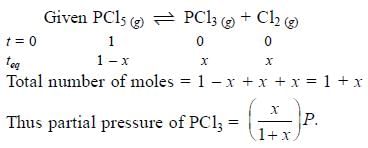
Which of the following equilibria is not affected by change in volume of the flask [AIEEE-2002]- a)PCl5 (g)
 PCl3(g) + Cl2(g)
PCl3(g) + Cl2(g) - b)N2(g) + 3H2 (g)
 2NH3(g)
2NH3(g) - c)N2 (g) + O2 (g)
 2NO (g)
2NO (g) - d)SO2Cl2 (g)
 SO2(g) + Cl2(g)
SO2(g) + Cl2(g)
Correct answer is option 'C'. Can you explain this answer?
Which of the following equilibria is not affected by change in volume of the flask [AIEEE-2002]
a)
PCl5 (g)  PCl3(g) + Cl2(g)
PCl3(g) + Cl2(g)
b)
N2(g) + 3H2 (g)  2NH3(g)
2NH3(g)
c)
N2 (g) + O2 (g)  2NO (g)
2NO (g)
d)
SO2Cl2 (g)  SO2(g) + Cl2(g)
SO2(g) + Cl2(g)
|
|
Gaurav Kumar answered |
Change in volume affects number of moles per unit volume and move in the direction which undo the change.
N2(g)+ O2(g) ⇄2NO(g)
Number of moles of reactants and products are equal.
Chapter doubts & questions for Equilibrium - Physical Chemistry for NEET 2025 is part of NEET exam preparation. The chapters have been prepared according to the NEET exam syllabus. The Chapter doubts & questions, notes, tests & MCQs are made for NEET 2025 Exam. Find important definitions, questions, notes, meanings, examples, exercises, MCQs and online tests here.
Chapter doubts & questions of Equilibrium - Physical Chemistry for NEET in English & Hindi are available as part of NEET exam.
Download more important topics, notes, lectures and mock test series for NEET Exam by signing up for free.

Contact Support
Our team is online on weekdays between 10 AM - 7 PM
Typical reply within 3 hours
|
Free Exam Preparation
at your Fingertips!
Access Free Study Material - Test Series, Structured Courses, Free Videos & Study Notes and Prepare for Your Exam With Ease

 Join the 10M+ students on EduRev
Join the 10M+ students on EduRev
|

|
Create your account for free
OR
Forgot Password
OR
Signup to see your scores
go up
within 7 days!
within 7 days!
Takes less than 10 seconds to signup

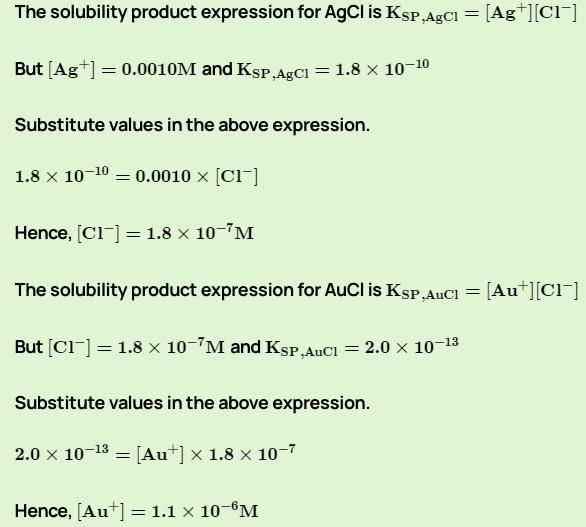
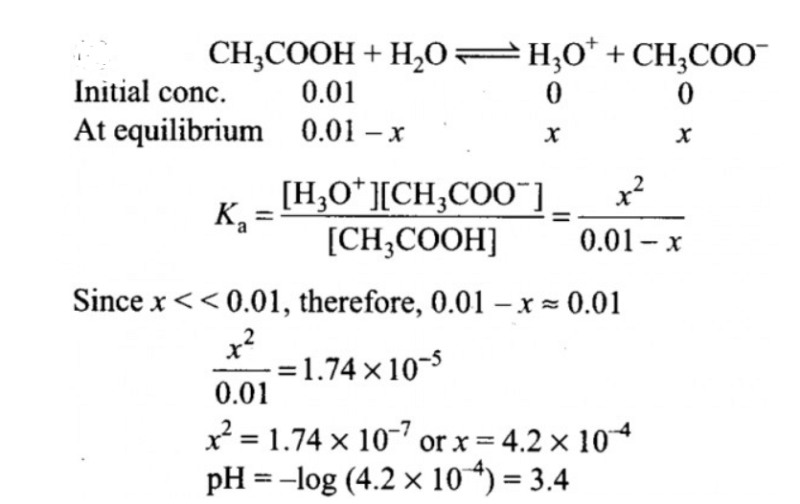
 H2(g) + I2(g), the degree of dissociated (α) of HI(g) is related to equilibrium constant Kp by the expression :
H2(g) + I2(g), the degree of dissociated (α) of HI(g) is related to equilibrium constant Kp by the expression :











